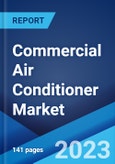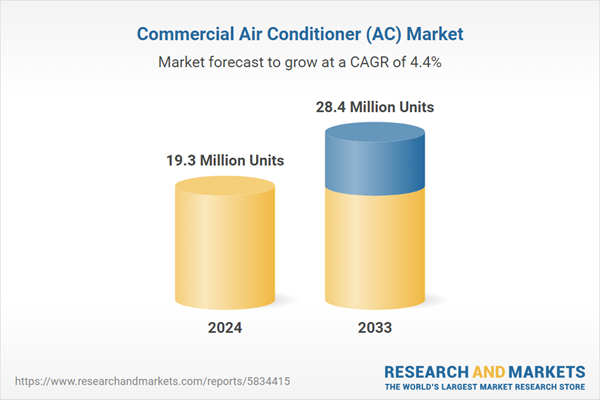Commercial air conditioners are electrical appliances designed to chill, heat, and dehumidify air in defined, usually enclosed spaces. They rely on a refrigeration cycle to treat the air and work by drawing the warm air from the room and replacing it with cooler air. They generally combine the heating and cooling systems into a single rooftop unit for optimum energy consumption. They aid in maintaining a comfortable temperature and air quality for customers and employees in commercial spaces of all sizes. They are widely available in different cooling capacities, power, and settings, such as chillers, central air conditioning systems, packaged units, and multi-split and ductless mini-split air conditioners. Since these units require a significant amount of space, they are commonly installed on the rooftops of buildings, which also assists in preventing noise from disturbing the inhabitants or business operations. As a result, commercial air conditioners are extensively deployed in various commercial settings, including shopping malls, offices, schools, gyms, hotels, restaurants, shops, and movie theaters.
Commercial Air Conditioner (AC) Market Trends:
Due to the rapid growth of the hospitality and travel and tourism industries, there is a surge in the installation of advanced systems in hotels, restaurants, and resorts to improve guest satisfaction, comfort, and retention. This, coupled with the escalating demand for energy-efficient cooling systems, especially from regions with soaring temperature and humidity levels, represents the primary factor driving the market growth. Additionally, the combined effects of ozone layer depletion and constantly worsening climate conditions owing to elevating air pollution levels and global warming have led to a gradual increase in the average temperature worldwide. In line with this, the rising acceptance of air conditioning systems as utility products instead of luxury items on account of climate change has augmented the product demand to maintain cool and comfortable temperatures in commercial spaces. Furthermore, the introduction of stringent government regulations on refrigerants is prompting manufacturers to develop energy-efficient and eco-friendly products. Along with this, the launch of innovative product variants by key players, such as commercial air conditioners embedded with energy-saving features and inverter and air purification technologies, has catalyzed the market growth. Other factors, including rapid urbanization and industrialization, increasing construction of commercial spaces, improving lifestyles, and ongoing technological advancements, are also anticipated to provide a positive thrust to market growth.Key Market Segmentation:
The publisher provides an analysis of the key trends in each segment of the global commercial air conditioner (AC) market, along with forecasts at the global, regional, and country levels from 2025-2033. Our report has categorized the market based on type, installation type, and end user.Type Insights:
Commercial Air Conditioner (AC) Market
- Chillers
- Split Units
- Packaged Unit
- Variable Refrigerant Flow (VRF)
- Others
Installation Type Insights:
- New Installation
- Retrofit
End User Insights:
- Healthcare
- Educational/Institutional
- Public/Government
- Retail
- Hospitality
- Manufacturing
Regional Insights:
- North America
- United States
- Canada
- Asia-Pacific
- China
- Japan
- India
- South Korea
- Australia
- Indonesia
- Others
- Europe
- Germany
- France
- United Kingdom
- Italy
- Spain
- Russia
- Others
- Latin America
- Brazil
- Mexico
- Others
- Middle East and Africa
Competitive Landscape:
The report has also provided a comprehensive analysis of the competitive landscape in the global commercial air conditioner (AC) market. Competitive analysis such as market structure, market share by key players, player positioning, top winning strategies, competitive dashboard, and company evaluation quadrant has been covered in the report. Also, detailed profiles of all major companies have been provided. Some of the companies covered include Airedale International Air Conditioning Ltd. (Modine Manufacturing Company), Blue Star Limited, Carrier Global Corporation, Daikin Industries Ltd., Fujitsu General Limited, Gree Electric Appliances Inc., Haier Group Corporation, Hitachi Ltd., LG Electronics Inc., Mitsubishi Electric Corporation, Panasonic Holdings Corporation, Samsung Electronics Co. Ltd., Voltas Limited, etc. Kindly note that this only represents a partial list of companies and the complete list has been provided in the report.Key Questions Answered in This Report:
- How has the global commercial air conditioner (AC) market performed so far, and how will it perform in the coming years?
- What are the drivers, restraints, and opportunities in the global commercial air conditioner (AC) market?
- What is the impact of each driver, restraint, and opportunity on the global commercial air conditioner (AC) market?
- What are the key regional markets?
- Which countries represent the most attractive commercial air conditioner (AC) market?
- What is the breakup of the market based on the type?
- Which is the most attractive type in the commercial air conditioner (AC) market?
- What is the breakup of the market based on the installation type?
- Which is the most attractive installation type in the commercial air conditioner (AC) market?
- What is the breakup of the market based on end user?
- Which is the most attractive end user in the commercial air conditioner (AC) market?
- What is the competitive structure of the global commercial air conditioner (AC) market?
- Who are the key players/companies in the global commercial air conditioner (AC) market?
Table of Contents
Companies Mentioned
- Airedale International Air Conditioning Ltd. (Modine Manufacturing Company)
- Blue Star Limited
- Carrier Global Corporation
- Daikin Industries Ltd.
- Fujitsu General Limited
- Gree Electric Appliances Inc.
- Haier Group Corporation
- Hitachi Ltd.
- LG Electronics Inc.
- Mitsubishi Electric Corporation
- Panasonic Holdings Corporation
- Samsung Electronics Co. Ltd.
- Voltas Limited
Methodology

LOADING...
Table Information
| Report Attribute | Details |
|---|---|
| No. of Pages | 139 |
| Published | March 2025 |
| Forecast Period | 2024 - 2033 |
| Estimated Market Value in 2024 | 19.3 Million Units |
| Forecasted Market Value by 2033 | 28.4 Million Units |
| Compound Annual Growth Rate | 4.4% |
| Regions Covered | Global |
| No. of Companies Mentioned | 13 |









